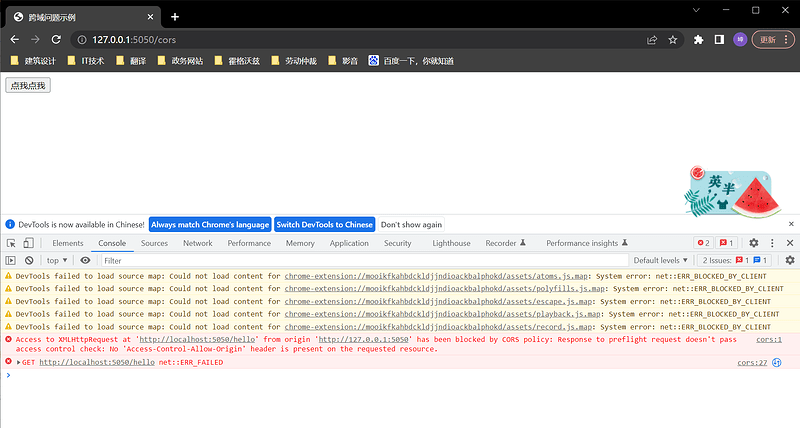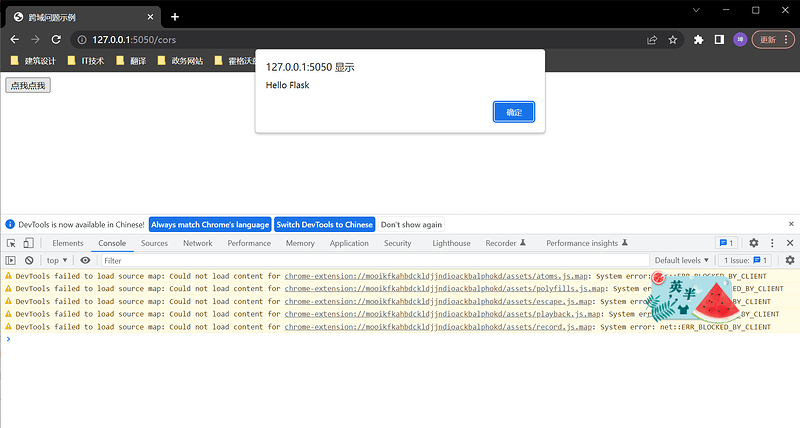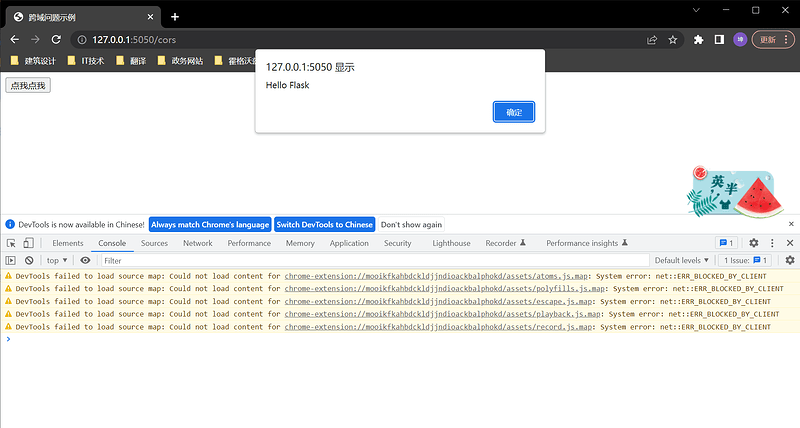一、跨域限制
在进行前后端联调的时候,可能会遇到下面这个报错:
Access to XMLHttpRequest at ‘http://127.0.0.1:5000/login’ from origin ‘http://localhost:8080’ has been blocked by CORS policy: Response to preflight request doesn’t pass access control check: No ‘Access-Control-Allow-Origin’ header is present on the requested resource.
这个错误就是跨域问题,是发生在浏览器端的。浏览器中有一个同源策略,它是一个安全策略,用来限制源的交互。
-
同源策略:是一种约定,是浏览器核心,也是最基本的安全功能,它会阻止一个域的JS脚本和另一个域的内容进行交互。如果缺少了同源策略,浏览器很容易受到XSS、CSFR等攻击。所谓同源(即在同一个域)就是两个页面具有相同的协议(protocol)、主机(host)和端口号(port)。
-
跨域:当一个请求URL的协议、域名、端口三者之间的任意一个与当前页面URL不同,即为跨域。
示例:
- 创建cors.py文件;
from flask import Flask, render_template
# 创建Flask应用程序实例
app = Flask(__name__)
# 定义路由和视图函数
@app.route("/hello")
def hello():
return "Hello Flask"
@app.route("/cors")
def cors():
return render_template("cors.html")
if __name__ == '__main__':
app.run(port=5050, debug=True)
- templates 目录下创建 cors.html;
<!DOCTYPE html>
<html lang="en">
<head>
<meta charset="UTF-8">
<meta http-equiv="X-UA-Compatible" content="IE=edge"/>
<meta name="viewport" content="width=device-width, initial-scale=1.0"/>
<title>跨域问题示例</title>
</head>
<body>
<div>
<button class="button" id="hello">点我点我</button>
</div>
</body>
</html>
<script type="text/javascript">
var btnHello = document.querySelector("button#hello");
btnHello.onclick = () => {
var xhr = new XMLHttpRequest();
xhr.onreadystatechange = function () {
if (xhr.readyState == 4 && xhr.status == 200) {
alert(xhr.responseText);
}
};
xhr.withCredentials = true;
xhr.open("get", "http://localhost:5050/hello", true);
xhr.setRequestHeader("Content-Type", "text");
xhr.send();
};
</script>
- 启动后端服务后,去访问前端页面,当点击按钮的时候,可以看到控制台报错:
二、解决跨域问题
cors是一个w3c的标准,全称跨域资源共享,允许浏览器向跨域服务器发出请求。
- 安装flask-cors :
pip install flask-cors - 解决跨域问题分为两种:
- 针对全局所有的API:
CORS(app) - 针对特定的API:
@cross_origin()
- 针对全局所有的API:
第一种方法:全局解决跨域问题
from flask import Flask, render_template
from flask_cors import CORS
# 创建Flask应用程序实例
app = Flask(__name__)
# 第一种方法:全局解决跨域问题
CORS(app, supports_credentials=True)
# 定义路由和视图函数
@app.route("/hello")
def hello():
return "Hello Flask"
@app.route("/cors")
def cors():
return render_template("cors.html")
if __name__ == '__main__':
app.run(port=5050, debug=True)
第二种方式:局部解决跨域问题(老师不推荐,未作讲解)
另外,还可以结合蓝图去使用:
from flask import Flask, render_template, Blueprint
from flask_cors import CORS
# 创建Flask应用程序实例
app = Flask(__name__)
hello_route = Blueprint("hello", __name__, url_prefix="/hello")
CORS(app, supports_credentials=True)
# 定义路由和视图函数
@hello_route.route("")
def hello():
return "Hello Flask"
@app.route("/cors")
def cors():
return render_template("cors.html")
if __name__ == '__main__':
app.register_blueprint(hello_route)
app.run(port=5050, debug=True)





